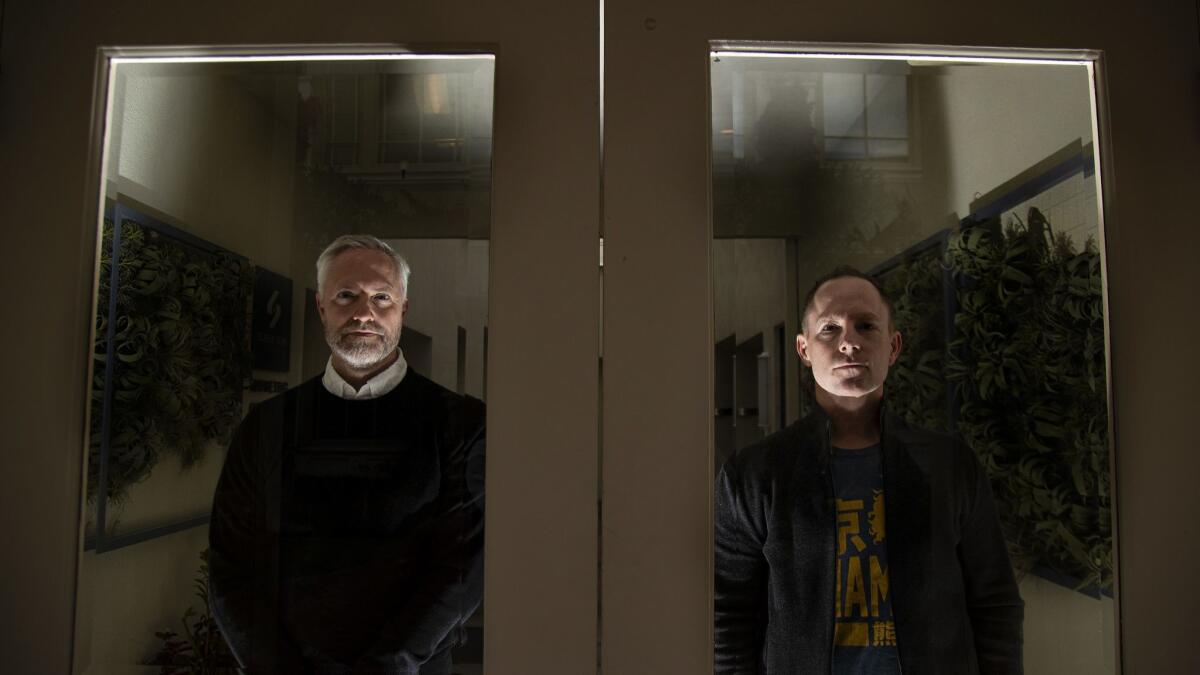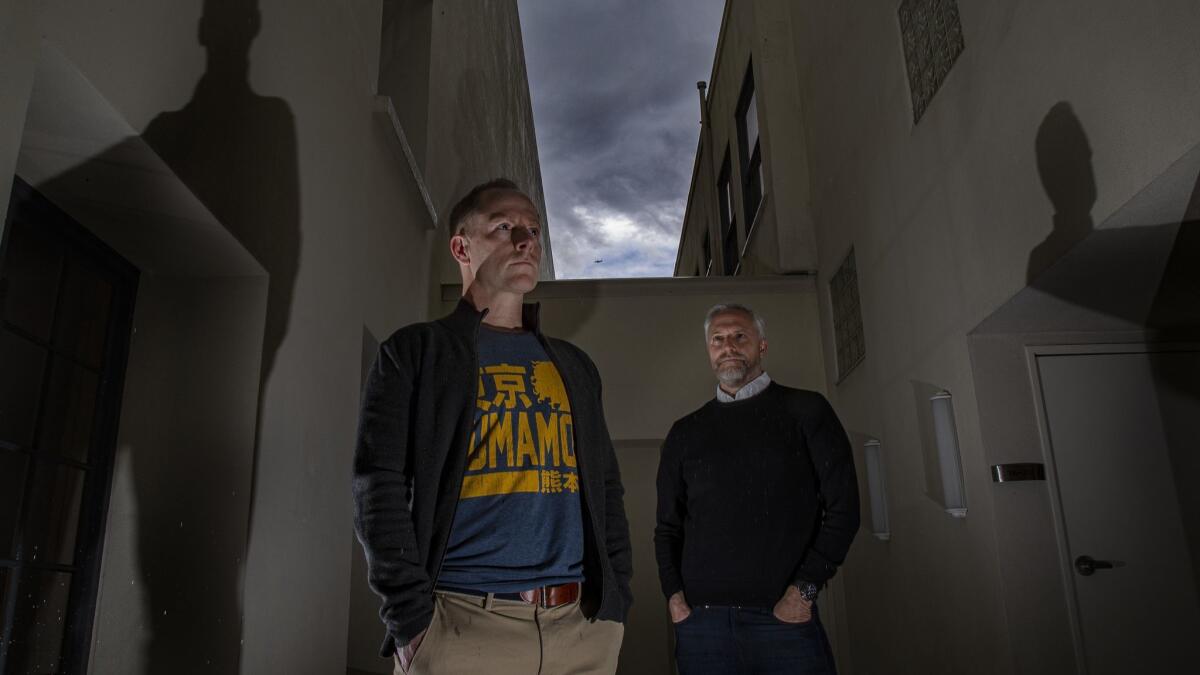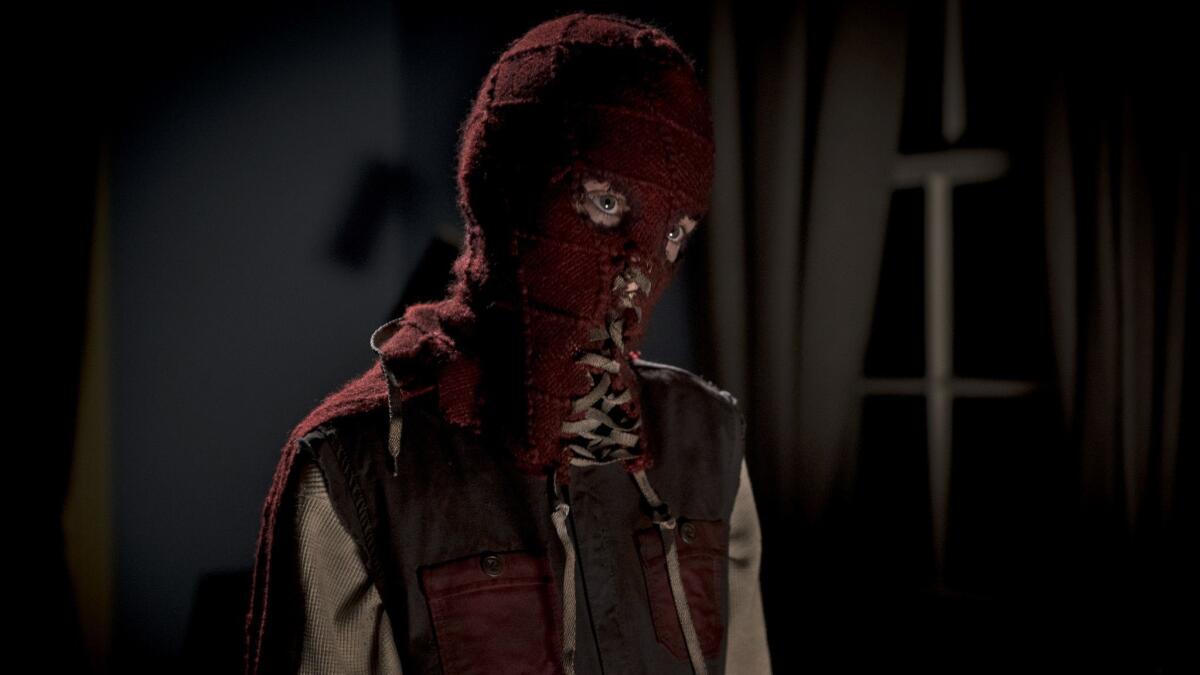‘Brightburn’ writers Mark and Brian Gunn don’t want you to side with their antihero

- Share via
Warning: The following article contains minor plot spoilers for the Sony horror “Brightburn.” You’ll see another warning before discussion of the film’s last act.
In a cinematic universe seemingly overrun with superheroes, the new horror movie “Brightburn” flips Superman’s mythology on its head by imagining what might’ve happened had the Man of Steel sided with the forces of evil rather than good.
The film opens with the discovery of a baby who crash-landed on Earth from unknown extraterrestrial origins. Upon discovering his heightened abilities, 12-year-old antihero Brandon Breyer (played by newcomer Jackson A. Dunn) immediately resolves to subjugate the planet and terrorize the people closest to him.
Despite the complete lack of a moral compass, early audiences were unsure whether to root for or against the prepubescent killer.
“We actually were at a screening last night and Brandon committed a horrific murder and at least a dozen people burst out into applause,” said screenwriter Brian Gunn, who co-wrote the script with his cousin Mark. “And I was like, ‘Huh?’”
“There were these teenagers sitting next to me, one of which was my son, going, ‘Why are people clapping?’” said Mark. “It’s a strange thing that happens in horror movies sometimes where audiences aren’t quite sure how to react to things and that can be exciting.”
“But it was a hard thing to shake,” said Brian. “We had other test screenings where the audience just identified with Brandon because he wears a cape...”
“And is a picked-on kid,” said Mark.
“Right,” said Brian. “And most movies that people see, capes equal hero. We really wanted to explore what happens when cape equals villain.”
Directed by David Yarovesky and produced by Brian’s older brother, “Guardians of the Galaxy” director James Gunn, the film stars Elizabeth Banks and David Denman as Brandon’s well-meaning adopted parents.
After struggling to conceive a child of their own, they take in the fallen alien baby, a trope that is often depicted in stories but rarely to such disastrous effect.
“There’s a few of those in comic book history, babies who are taken in by families that aren’t their own and raised up,” said Mark. “There’s Moses in the Bible....Some of those babies turn into heroes but we were interested in one that wasn’t heroic at all.”
“We [also] liked playing with this trope where a kid might be bullied and picked on and there’s this wish fulfillment of getting enough strength and power that you can take on your adversaries,” said Brian. “And we wanted to really explore what happens when that’s taken too far.”
While the audience can decide for themselves whether to root for or be reviled by Brandon’s increasingly sociopathic actions, the screenwriters revealed that they never intended for moviegoers to cheer on Brandon.
“We hope that at the beginning of the movie you’re rooting for this boy as he gets picked on and seems like an underdog,” said Mark. “But by the end of the movie, I think you should be rooting against him. His change over the course of the movie is pretty stark and by the end he is not someone anyone [should be] rooting for.”
“By a certain point where he starts actually physically hurting other people, we do not intend the audience to be on Brandon’s side,” added Brian.
Having the opportunity to work with James (who is no stranger to the horror genre with 2006’s “Slither”), was “a joy,” Mark says.
“I can remember when I was a little kid, James getting out the old Super 8 camera and filming us in zombie makeup with fake blood and fake entrails coming out of our guts,” said Brian. “We were, in a sense, making horror movies together back from the time I can barely remember. And so it was really cool to see that come full circle and do that professionally.”

Similar to the filmmakers behind this year’s Taylor Schilling-starring “The Prodigy,” the Gunns were inspired to explore the challenges of parenthood through the lens of horror.
“Brian and I are both parents and we were wondering what it would take for someone to be desperate enough to find an alien child in their backyard and bring it in and raise it as their child,” said Mark. “In a lot of stories where that happens, it works out beautifully. We were interested in the flip side of that: What happens if it turns out terribly?”
“In a lot of ways, bringing a child into your home is like bringing a stranger in, you never know exactly how they’re going to turn out,” he added. “We were interested in exploring that conflict between the parents as they debated nature versus nurture: Is this child born bad? Or can we love him enough to make him good?”
Mark, who has children around Brandon’s age, likened the film to “a horror version of puberty from the parent’s point of view” in the vein of Stephen King’s “Carrie.”
“To us, the best horror movies are about real-life neuroses and fears that many of us have, played out in an exaggerated way,” he said. “We wanted to take a sort of exaggerated, horrific look at the possibilities of raising a troubled child.”
“Most of our favorite horror movies, I think, dramatize some common human experience,” said Brian. “And particularly that roll of the dice you take with raising a child. You’ve got some control over them but sometimes it’s ‘you get what you get.’ ”
The movie’s violence is particularly gory and explicit, even by the standards of an R rating.
“We’d like to think that the gore is slightly heightened,” said Brian. “Not quite to the point of tongue-in-cheek, but to the point where you can allow yourself to almost nervously laugh at it because it’s a little bit over the top.”
“That stuff is a kick to us,” said Mark. “But Dave really took it up a notch. The scene where the woman pulls the shard of glass out of her eyeball is still my favorite scene in the movie. It makes me laugh every time I see it but it’s not going to be for everyone and we understand that.”
The writers say they took special care not to glorify Brandon’s anarchy, particularly in an era when white male rage has manifested itself in the form of school shootings, “incel” (involuntarily celibate) factions online and the rise of the alt-right.
“We hope that his rage is not glorious at all,” said Mark. “That it’s something that the audience will be sickened by. And that the actions he takes hopefully leave you feeling queasy about who he is, what he’s done and what he’s become.”
In fact, Brian names the book “Far From the Tree,” which includes accounts from Columbine shooter Dylan Klebold’s parents, as a point of reference during the writing process.
“I really felt for the parents there,” he said. “Some of what the parents go through in this movie is based on some of the experiences of Dylan Klebold’s parents.”
Despite early enthusiasm for the character, Mark said the thought of kids wearing “Brightburn” costumes is “a little alarming.”
“Well, you know people do dress in Halloween masks of people you’re supposed to be afraid of,” said Brian.
“People do wear Darth Vader masks a lot,” Mark agreed. “I don’t think that means they support the destruction of galaxies necessarily.”
Warning: Spoilers for the last act of “Brightburn” follow. Stop reading if you’d like to preserve the twists.

“Brightburn” builds to a final confrontation between Brandon and his mother, in which Brandon tells her that he actually wants to do good. It’s unclear whether the sentiment is genuine or another one of his manipulations.
“I think there is a part of him that is saying that because he believes it,” said Mark. “But a large part of him that’s saying it as another attempt to manipulate his mother. Because there are instances before that where he’s clearly trying to manipulate and lie to his parents, to varying degrees of success. He’s not even very good at it, he’s still a 12-year-old and he’s sort of clumsy about it. But I think at that point he is trying to get into her good graces and get her sympathy and it doesn’t work.”
By the end of the film, Brandon is firmly cemented as purely evil, racking up a high body count and exhibiting no redeeming qualities to speak of.
“This is an origin story about a super villain,” said Mark. “And like most origin stories, he doesn’t start out one way or the other. It’s sort of a series of choices.”
“And it was also important that he not only be evil but that he be seemingly unstoppable,” said Brian. “We really wanted to play with the idea that the shard of Kryptonite so to speak at the end might save the mother. We really wanted to put the characters in a seemingly impossible situation to see how they could mousetrap their way out of it.”
The film originally ended with good prevailing and Brandon’s mother managing to kill her son.
“I think it was James who said, ‘No, he should win. Evil wins,’” Mark recalled. “And last night at the screening, I was sitting next to a bunch of teenagers and afterwards they told me that their favorite thing about the movie was that evil won.”
He laughs. “I think it’s partly a response to having a steady diet of superhero movies over the last 10 years where good wins. It was different to them and they found it exciting.”
“That doesn’t express our worldview that we think the world is evil,” Brian clarified. “We just thought it was narratively more surprising.”
Made on a relatively low budget, in success “Brightburn” could inspire an alternate universe of anti-superhero characters. The writers already have plans for what could happen in follow-up movies.
“We have a lot of ideas not just for a sequel but for other characters in this vein, for a universe,” said Mark. “But we’ll see how this movie does and if there’s an appetite for it.”
In fact, in a post-credits scene, it’s suggested that there are other malevolent forces wreaking havoc on the planet besides Brandon.
“There are hints at the end of the movie that there is a larger universe of super-beings out there,” said Brian. “The movie seems to suggest that they’re all villainous.”
“But we like to think that there are countervailing forces out there to these evil super villains that will ideally one day play a role in this universe,” said Mark.
follow me on twitter @sonaiyak
More to Read
Only good movies
Get the Indie Focus newsletter, Mark Olsen's weekly guide to the world of cinema.
You may occasionally receive promotional content from the Los Angeles Times.











